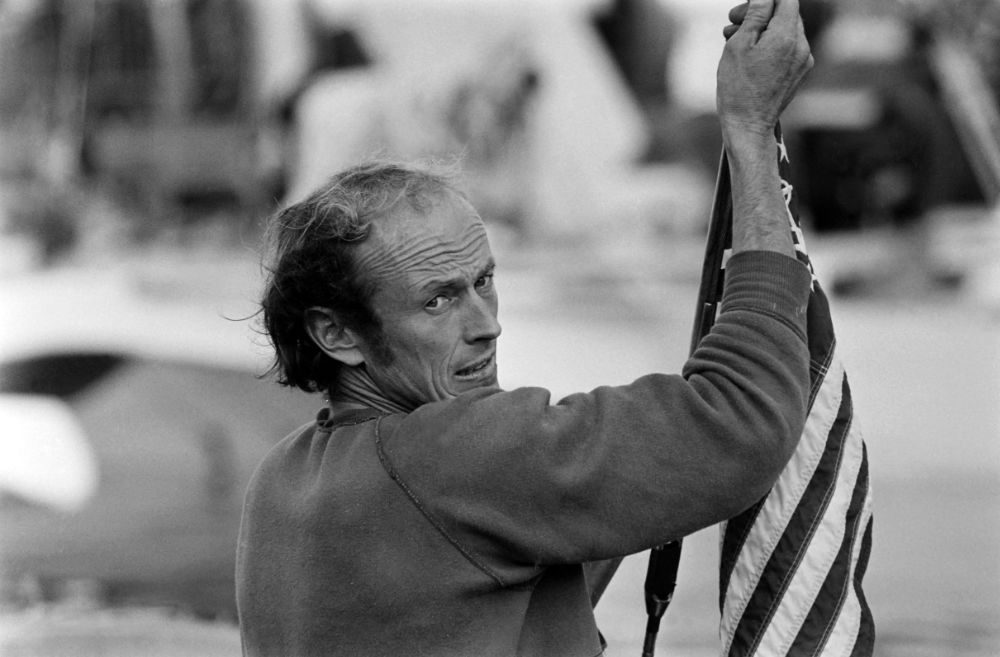Legendary Canadian ocean racer Mike Birch who won the first edition of the Route du Rhum by just 98 seconds passed his final finish line when he died peacefully at the age of 90 during the night of Tuesday into Wednesday at his home in NW France.
The entire Route du Rhum community, preparing in Saint-Malo for the start of the 12th edition of the race, is in mourning. The famous solo Transatlantic race owes a huge debt of gratitude to Birch who at the age of 47 started it all when in 1978, his little yellow trimaran won the race by 98 seconds ahead of Michel Malinovsky’s bigger, more powerful monohull.
A minute of silence was to be observed in the race village in his honor at 5 p.m., at the time of the inauguration of the race village. The sailor’s photo will be projected on the ramparts of Saint-Malo this evening and until the skippers leave on Sunday 6 November.
Anyone who has ever raced or dreamed of multihull ocean racing remembers the image of Mike Birch. That of his Olympus Photo first, fighting against the trade winds in the Canal des Saintes to snatch victory from a monohull twice its size in the first edition of the Route du Rhum – Destination Guadeloupe. “98 seconds for eternity” proclaimed the newspapers at the time, “Only victory is pretty” Michel Malinovsky said in his book and they were right. The revolution was started and the Canadian’s diminutive Walter Greene moulded wood plan was the detonator.
Birch’s soft gaze lighting up an emaciated face, a dancer’s physique that composed with the sea more than it confronted it, first seeking harmony with the ocean in its choreographies. A way of sailing very much his own, which has shown the way to many sailors for whom he has been a mentor. Among them, Charlie Capelle, who will start his 7th Route du Rhum – Destination Guadeloupe on November 6 on A Capella – La Chaîne de l’Espoir, sistership of Olympus Photo to which he worships, met Birch in the years 1980, in Maine in the United States. “I had the chance to do my apprenticeship with Walter Greene, in a shipyard where he was building a boat with his family. He began his career after his victory over Rum. I participated in the construction of this boat with other mates and if I had not met Mike, I probably would never have done offshore racing. He was a friend, a mentor, my own hero. I had a deep admiration for this gentleman who was very accessible, very calm, very nice, who was not in the star system. He was a very discreet and very reliable person. When he said something, he did it.
A character à la Jack London
Before offshore racing, Mike Birch learned his trade as a sailor which was far from being his first vocation. Born in Vancouver, he was in turn a miner, an oil worker, a cowboy, before taking another look at the horizon. “A character from a novel” summed up Thomas Coville this morning, who had sailed with him on the ORMA Fujicolor trimaran in the 1990s. “I discovered very late that he had had this life before and rode the great outdoors. I read his book, one of the rare seafaring books that I read to the end, as if I had read a story by Jack London. This gentleman has always been young.
Yet it was at the age of 44 that Mike Birch lined up at the start of his first transatlantic race, the formidable 1976 edition of the OSTAR between Plymouth and Newport. He followed up on his victory in the 1978 Route du Rhum and then built several multihulls to Nigel Irens designs. First the small 50-footer Vital then Formula Tag, a large 26-meter catamaran which gave him victory in Monaco New York in 1985. Then came the ORMA years, these 18.28 m trimarans on which Mike won twice third place on the Route du Rhum – Destination Guadeloupe.
The queen of Transatlantics was inseparable from the life of the sailor, he who lined up seven times at the start. “The death of Mike Birch is an event that marks us, within the organization of the Route du Rhum – Destination Guadeloupe said this morning Joseph Bizard, General Manager of OC Sport Pen Duick. “In the story of this great sailor, we find the magic, the myth, the adventure, everything that made the race a real popular and sporting success. There is in its history the human adventure of the sailor, the sporting adventure, the technological adventure because his victory marked the advent of multihulls. His arrival 98 seconds ahead of Malinovsky laid the cornerstone of what is the DNA of the Route du Rhum – Destination Guadeloupe, the marker that made the magic of the race. He marked the history of sailing and that of the Route du Rhum – Destination Guadeloupe”.

